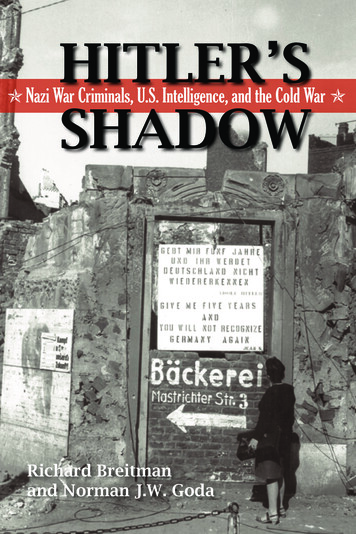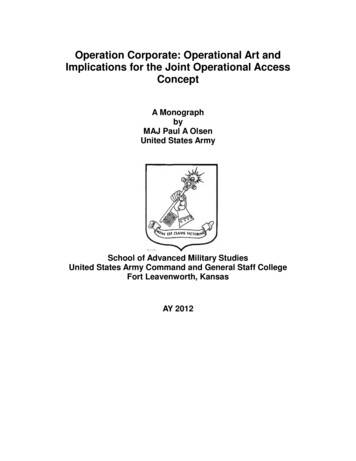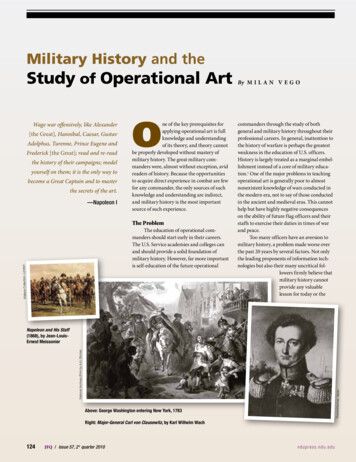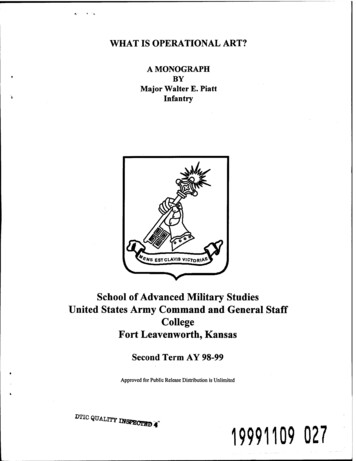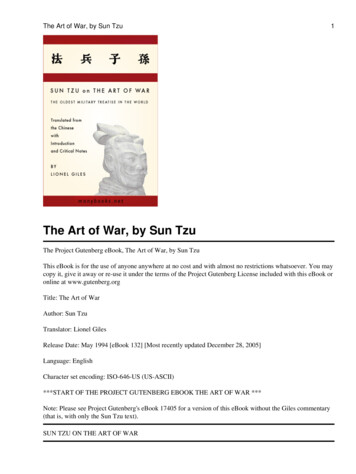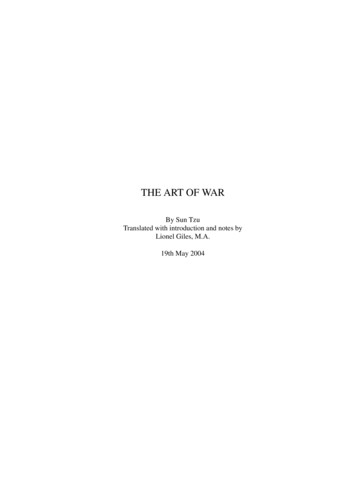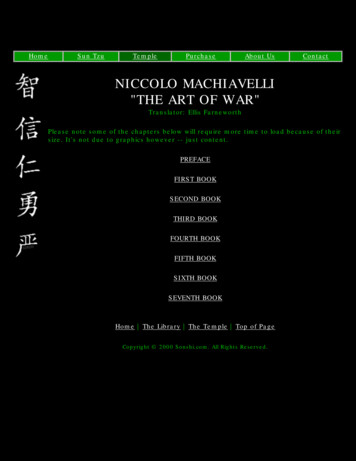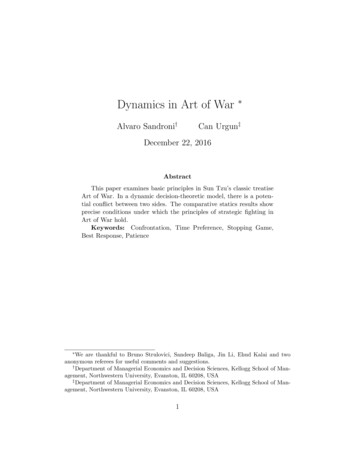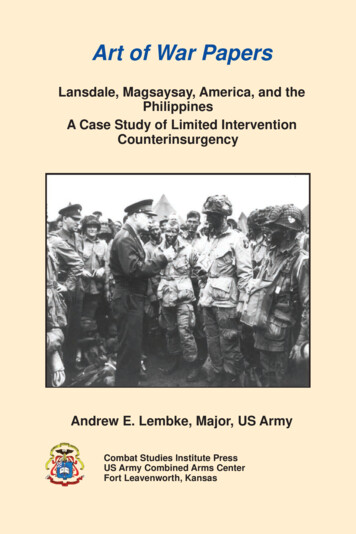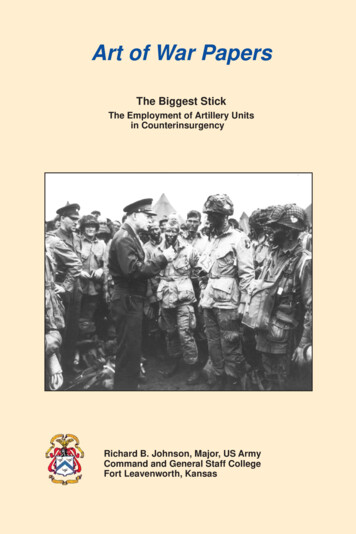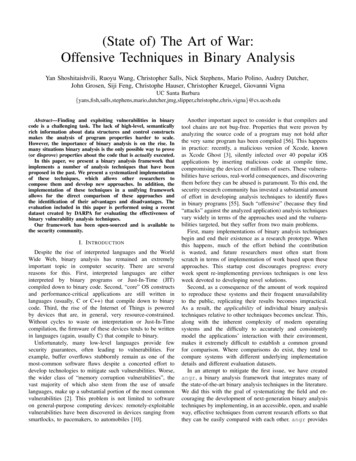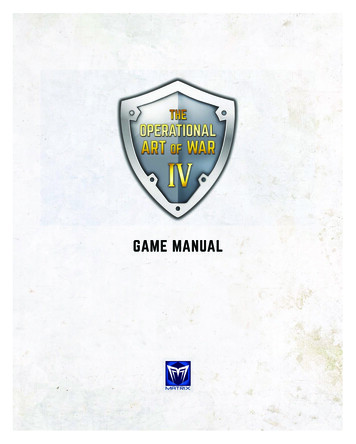
Transcription
GAME MANUALOperational Art of War manual.indd 126/09/2017 11:08
CONTENTS1. WELCOME51.1. Installation51.3. Game Forums61.2. Product Updates1.4. Technical Support57.12. Standard Unit Icons317.14. Displayed Bombardment Range(DBR)337.13. Unit Icon Display (Advanced Rules) 3268. PLAYING THE GAME342. INTRODUCTION78.1. Game Definitions343. STARTING THE GAME83.1. Play New Game83.2. Resume Saved Game3.3. Set Game Options3.4. Edit Scenario910194. STANDARD RULES205. ADVANCED RULES206. INTERFACE CONVENTIONS216.1. General Usage217. GAME DISPLAYS277.1. The Menu277.3. The Editor’s File Menu277.2. The Game’s File Menu7.4. The Play Menu7.5. The Game’s View Menu7.6. The Editor’s View Menu7.7. The Options Menu7.8. The Help Menu7.9. The Sound Menu7.10. The Mouse Cursor7.11. Unit Health IndicatorsOperational Art of War manual.indd 2272728288.2. Unit Characteristics and TheirEffects358.3. Unit Special Capabilities398.5. Force428.4. Equipment8.6. Formation9. WHAT HAPPENS DURING A GAMETURN9.1. Automatic Book keeping4047495010. YOU ISSUE ORDERS TO YOUR FORCES 6310.1. Variable Initiative10.2. Using the Game Control Panel10.3. Selecting Theater Options(Advanced Rules)10.4. Giving Orders to Your Units6364666610.5. Attack Menus and Attack Planning(Advanced Rules)6911. MOVEMENT722911.1. Naval Movement723011.3. Railroad Movement7230303111.2. Air Movement11.4. Seaborne Movement11.5. Airborne Movement72737326/09/2017 11:08
11.6. Airmobile Movement7313.17. Airborne Attacks9011.8. Movement Costs and Allowances7513.19. Effects of Entraining Units9014. YOUR ENTIRE FORCE MOVEMENTALLOWANCES ARE ADJUSTED9211.7. Embarked Status11.9. Land Unit Movement Costs11.10. Skipping the Unit MovementPopup11.11. PO Assist12. ENGINEERING12.1. Demolition / Bridge repair(Advanced Rules)12.2. Ferry Support12.3. Major Ferry Support12.4. Fortification (Advanced Rules)12.5. Railroad Repair (Advanced Rules)13. ALL BATTLES ARE RESOLVED13.1. Airbase Defense13.2. Air and Naval Units in LandCombat13.3. Naval Combat13.4. Naval Targeting13.5. Port Attacks13.6. Nuclear Attacks13.7. Airfield Attacks13.8. Bridge Attacks13.9. Battlefield Reconnaissance13.10. Target Density (Advanced Rules)13.11. Long-Range Supporting .12. Environmental Effects on Combat(Advanced Rules)8713.18. Airmobile Attacks13.20. Assault Ratio Rules9214.3. The Turn Ends9414.2. Turn Over9416. INFORMATION AND PLAYER AIDS9516.1. The Unit Report (Advanced Rules) 9516.2. The Formation Report(Advanced Rules)9716.4. The Attack Planning Window(Advanced Rules)9816.3. The Air Unit Report9816.5. Planned Combats10016.7. The Scenario Briefing10216.6. The Situation Briefing16.8. The Air Briefing16.9. The Weather Briefing(Advanced Rules)16.10. The Expected ReinforcementsBriefing16.11. The Recent ReinforcementsBriefing8913.15. Attack Complexity (Defined)8916.14. Group CompositionOperational Art of War manual.indd 39315. VICTORY13.13. Flanks and Rear Areas13.16. Amphibious Attacks9014.1. Battlefield Time Stamps16.12. Inventory and ReplacementsBriefing13.14. Retreats901011031031031041048916.13. Recent News1059016.15. Order of Battle: Units Report10510526/09/2017 11:08
16.16. Order of Battle: FormationsReport16.17. Theater Options Report10610616.18. Equipment Report10616.20. Loss Report10816.22. Combat Chart Legend11016.19. Detailed Combat Report16.21. Combat Chart16.23. Combat Review16.24. The Editor’s Edit Menu17. CREATING SCENARIOS WITH THESCENARIO EDITOR10711111711812913117.9. The Event Editor13313213914117.12. Game Options Preferences Preset 14918.1. Use the Scenario Dump Feature18.2. Talk to Other Scenario Designers18.3. Study Dumps of the Existing418.9. Formations18.11. Supply19. APPENDICES13218. GENERAL NOTES ON SCENARIOCREATION18.7. Unit Deployments and Air UnitMissions15215417.7. Weather Zones17.11. The Deployment Editor15215118.10. Units17.4. Advanced Force Editor Functions 12917.10. The Replacement Editor18.6. Maps18.5. Make it Fit11012217.8. The Calendar Editor15115217.3. The Force Editor17.6. The Environment Editor18.4. The Event Engine18.8. Forces11717.5. The Equipment Editor15110817.1. The Scenario17.2. The Map EditorScenarios15015015019.1. Calculations15215715815819.2. Notes On Combat Resolution15919.4. Naval Combat Procedure16119.3. Seeing the Elephant16119.5. Naval Repair Procedure16419.7. Naval Spotting Procedure16519.6. Sea Interdiction Procedure19.8. Splitting TO&E Lines16416619.9. The Equipment.nqp File16819.11. Opart4 Fonts.ini File17219.10. Opart4.ini File20. GAME HINTS20.1. Using Air Units16917317320.2. Combat Planning Considerations17320.4. Keeping Your Units Supplied17420.3. Nuclear Weapons21. CREDITS174175THE OPERATIONAL ART OF WAR IVOperational Art of War manual.indd 426/09/2017 11:08
of units in a location to a smaller number. The preciselimit depends upon the equipment assigned to theunits involved, but a good rule of thumb might beto limit stacking to no more than three units of eachtype (Land/Sea/Air) per location.Orders Scope (Advanced Rules)When you give orders to your Forces, the effectscan apply to either a single unit, a group of unitsin a single location, or all units that can possiblyparticipate in a given action:§ Single Unit Orders Scope: Your orders applyonly to the current unit.§ Single Group Orders Scope: Your ordersapply to all units occupying the current unit’slocation.§ All Units Orders Scope: Your orders apply to allunits that can participate in a particular action– typically an attack on an enemy position.Note that this will add units regardless of theirFormation, and may trigger non-cooperativeunit penalties.89. WHAT HAPPENS DURING A GAME TURNEach game is divided into a number of Turns, sothings happen in a specific order during each Turn.First, the game performs automatic bookkeeping,then you and your opponent issue your orders, and9the program determines the results. When bothplayers’ orders have been resolved, the Turn ends.9.0.1 PBEM PLAYBACKWHAT HAPPENS DURING A GAME TURNOperational Art of War manual.indd 494926/09/2017 11:09
If you start a PBEM turn, you will be shownthe PBEM Playback screen. This will give you theopportunity to view the moves and battles that youropponent made during his previous player-turn.The Info Panel will show the number of movescontained in the playback. There are five buttonson the Control Panel: Rewind, Stop, Step, Play,and Exit. The Step button advances one move ifleft-clicked. If right-clicked it will backup one step.Once the Exit button is selected the game will exitthe playback and begin the Automatic Bookkeepingphase. Once that starts, you will not have anotheropportunity to view the playback – withoutreloading the turn (which can trigger an indicationthat you reloaded the turn.) Furthermore, a bellwill ring during your playback when your opponentused the “undo” button.Note: The system monitors how many times you’vereloaded without saving. You can always reload afile you’ve saved since the last time you opened itwithout generating such a message.9.0.2 PLAYER-TURN EQUALIZATION (AKA“NEW TURN ORDER RULES”) (OPTIONAL)There is now an Advanced Rules Option to useequalized player-turns. The old pre-turn calculationmethod used to do all the calculations for supply,recovery, and other items at the start of the firstplayer turn. This was a bit unfair (usually to thesecond player). The new turn order splits thatprocessing into three parts. Air-Combat, Events,and Weather effects still happen at the beginningof the game turn. But everything else now happensat the beginning of each respective player-turninstead. Clouds even move between player-turns –just without weather effects.Note that equalization will mean that enemyunits cut off from communications in the friendly50player-turn will be unsupplied in the immediatelyfollowing enemy player-turn regardless of side(previously an unfair advantage for side-two).Also, note that movement recovery is done twicefor each side (start of each player-turn). Thiswill clear the “Retreated” condition for bothsides during their own player-turn (previouslyan unfair advantage for side-one). It may evenmake use of reserve deployments more palatableto players.Furthermore, neither side is assumed to have100% visibility into their own territories duringthe enemy movement phase (previously an unfairadvantage for side-two). Rather, detection ofenemy moves into friendly territory will nowdepend upon the friendly Theater Recon Levelor friendly units. Therefore, enemy units will nowbe better able to slip around either player withoutnotice.9.1. AUTOMATIC BOOK KEEPING§ An End of Scenario check is made and thecalendar is adjusted.§ Out of Theater events occur (including unitwithdrawals).§ Weather is determined.§ Theater Air Superiority and Interdictionstrengths are determined.Under New Turn Order Rules, the following stepsare split so that each side does them at the start oftheir respective player-turns:§ Intelligence is gathered.§ Units and Security Forces conduct localpatrols.§ Your forces are resupplied, receive replacements,and prepare for the new Turn.§ Reinforcements appear.§ Unit Command and Control levels are set.THE OPERATIONAL ART OF WAR IVOperational Art of War manual.indd 5026/09/2017 11:09
9.1.1. END OF SCENARIO CHECKThere are two ways for a Scenario to endautomatically (at the discretion of the program):§ A Scenario will end when it reaches itsnominal final Turn. This nominal final Turncan change during a Scenario, so keep an eyeon it to avoid surprises.§ A Scenario will end if there are no Land unitsof one Force on the map.9.1.2. OUT OF THEATER EVENTSSome Scenarios are heavily influenced by Out ofTheater Events. These Events may be triggered byyour actions in the Theater. The most significantpotential Events should be detailed in the ScenarioDescription. Military decisions can have politicalconsequences; if an opportunity in the game lookstoo good to be true, check the Scenario Descriptionto make sure you won’t bring the sky crashing downaround your ears by taking advantage of it.The variety of potential Events is too great tobe fully described here. If you are curious about thekinds of things Scenario designers might throw atyou, check out the Event Editor (17.9).9.1.3. CLIMATE AND WEATHER(ADVANCED RULES)Weather is determined on a location-by-locationbasis, from Turn to Turn. Mountains are cooler.Locations adjacent to Shallow or Deep Water aremoderate. Cold and Warm weather fronts maymove across the Theater. Rain or Snow may resultin some locations becoming Snowy or Muddy, withsignificant effects on Movement.While any location with sub-freezing temperaturesis labeled as Very Cold, there are actually threedifferent levels of sub-freezing temperatures. Theaverage temperature of any Weather Zone is listedin the Weather Briefing. Water features (Rivers,Canals, Shallow Water, etc.) in Very Cold locationsmay or may not be Frozen. Rivers and Canals freezeat the Frozen 2 Level. Super Rivers and ShallowWater freeze at the Frozen 3 Level.Weather Effects on Bicycle and Ski UnitsBicycle and Ski unit icons are displayed only if localconditions are appropriate. Ski units are displayedas Infantry when in non-Snowy locations. Bicycleunits are displayed using Infantry icons when inVery Cold locations.Weather Effects on Chemical WeaponsChemicals are most lethal in Cool or Moderatetemperatures, with no Rain, and with Overcastconditions. They are least effective in Hottemperatures and Heavy Rain or bright sunlight.High temperatures, wind, and sunlight degradechemical agents. Rain washes them away andimpedes distribution. Chemicals can increaseReadiness losses in combat for both sides. They aremost tiring (3x) at higher temperatures, and havelittle Readiness effect at low temperatures. (Actually,it’s not the chemicals. It’s the damned protectivesuits that do the damage. You have to wear one ofthese things to believe how uncomfortable they are.)Weather Effects on Nuclear WeaponsNukes are most lethal in Hot temperatures, withno Rain, and Fair conditions. They are leasteffective in Cold temperatures, Heavy Rain, andOvercast conditions. This is due to a combinationof exposure and atmospheric transparency.9.1.4. AIR SUPERIORITY ANDINTERDICTIONAll of your air units perform Missions based ontheir Deployment status. See Unit DeploymentOrders (8.2.8) for more information.WHAT HAPPENS DURING A GAME TURNOperational Art of War manual.indd 5195126/09/2017 11:09
Air SuperiorityUnits assigned Air Superiority Missions attemptto destroy enemy aircraft flying Missions and toprotect friendly aircraft and locations. They willengage your opponent’s Air units only if thoseenemy Air units attempt to fly Missions. AllMissions performed by Air units are affected bythe local Air Superiority Strengths of each Force.Local Air SuperiorityAir units with Air Superiority Missions may ormay not participate in any particular local AirSuperiority combat. The chance that a unit willparticipate is based on the range to the unit’s base,its Force Electronic Support Level, and the unit’sQuality. High Quality units and those nearbyare more likely to participate than lower Qualityunits further from the location. A Force’s LocalAir Superiority Strength is the sum of Anti-AirStrengths of all participating friendly Air unitswith Air Superiority Missions.Even if no other Missions are flown, opposingunits with Air Superiority Missions may fight atthe beginning of each Turn when the game sparksa number of Air Superiority battles at randomlocations on the map.Theater Air SuperiorityThe program keeps track of Air Superiority unitsand calculates a Theater Air Superiority Level foreach Force. Theater Air Superiority is a generalindicator of Air Superiority in the theater. It ispresented solely for your information, and isn’tused by the game.InterdictionUnits assigned Interdiction Missions will attemptto intercept enemy Land units when those Landunits move and also impair your opponent’s ability52to supply his Force. Units performing InterdictionMissions are subject to Interdiction by enemy Airunits with Air Superiority missions and are protectedby friendly units with Air Superiority missions.Interdiction is less effective in poor weather andon night Turns.9.1.4.1. SEA INTERDICTIONNaval and embarked units moving in deep waterhexes are now subject to interdiction attacks asfollows:§ Air units that have an Anti-Naval strengthcan be set to a new deployment mode:“Sea Interdiction”. Such units will performinterdiction of detected moving naval andembarked units, just as air units set to“Interdiction” interdict detected moving landunits. Such units have the “T” deploymentmode letter on them. They do not interdictland unit movement, and have no impact onenemy Force Supply Levels. Only all-weatherair units conduct sea interdict at night.§ Surface ships and coastal guns also perform“Sea Interdiction” within their respectivegunnery ranges. This is automatic, and nodeployment setting is necessary.§ Ship units and embarked units moving by“Group Movement” defend as a group ifinterdicted by the above. Group Movementthus forms a “de facto” Task Force.§ Ship units interdicted or bombarded by otherships or coastal guns will fire counterbatteryback at them, if in range.§ Carrier ship units interdicted or bombardedby aircraft from enemy carriers will launchcounterstrikes against them, if in range andthe attacking carriers have been detected.§ Moving groups that are interdicted stop theirmovement to allow plan changes.THE OPERATIONAL ART OF WAR IVOperational Art of War manual.indd 5226/09/2017 11:09
§ Planes performing Sea Interdiction are, ofcourse, provided air cover by friendly in-rangeplanes set to Air Superiority.9.1.5. INTELLIGENCE GATHERING(ADVANCED RULES)You will never have complete information on thelocation of enemy Forces during a game. Theamount of information you do have is based on thetype and location of your Reconnaissance assetsand local environmental conditions.Levels of InformationYour knowledge of any particular map locationmay be:§ Unknown – You have no informationregarding the presence of enemy units.§ Observed – You know whether or not enemyunits are present, but their identity andstrengths are not evaluated.§ Spotted – You know of any enemy unitsthat are present, as well as their identity andstrengths.Reconnaissance Assets§ Units – All of your units have the abilityto detect, and in some cases evaluate, thestrengths of enemy units in nearby locations.§ Internal Security – All of the terrain you ownis considered either Observed or Spotted.Areas near dense Urban locations are morelikely to be Spotted.§ Theater Reconnaissance – This representseverything from spies on the ground toReconnaissance aircraft. The quality ofTheater Reconnaissance depends heavilyon environmental conditions. TheaterReconnaissance is capable of observinglocations, but cannot spot them.Intelligence UpdatesIntelligence information is updated at thebeginning of every Turn. Each of your units gathersinformation on nearby locations. Then yourInternal Security assets gather information yourrear areas and your Theater Reconnaissance assetsgather information on enemy-held areas.Generally, units and Internal Security assetscan only observe adjacent locations. If, however,the unit or Internal Security asset is observingfrom a location with a mountain peak, observationvisibility can be as far as 40 kilometers. Thismountain view advantage deteriorates withdecreasing visibility and during night turns. Notethat the mountain peak reconnaissance is receiveddynamically: If the peak is entered during a playerturn, the reconnaissance occurs immediately. Youdon’t have to wait for the inter-turn calculations.Likewise, if an adjacent location is viewedthrough an escarpment, the location is more likelyto be spotted by units “looking down” and less likelyto be spotted by units “looking up”. Note that thehex that contains the escarpment hexside is on thehigh side of it. The hex on the other side of it is onthe low side.Theater Reconnaissance is more likely to observelocations with Roads, Anchorage locations, Airbases,or large concentrations of Motorized equipment.Airfields with Air units will almost certainly beobserved. Theater Reconnaissance is less likely toobserve locations with Hills, Badlands, Mountains,Dense Urban, Light Woods, Jungle, or Forest terrain,as well as locations with hazy or (especially) overcastvisibility conditions. Theater Reconnaissance is alsoless effective during night Turns.Previously spotted locations will remain spottedas long as they remain under observation by anyof your Reconnaissance assets. Previously observedlocations may become spotted if they remain underWHAT HAPPENS DURING A GAME TURNOperational Art of War manual.indd 5395326/09/2017 11:09
observation. Locations no longer under observationbecome unknown.The level of Intelligence Information availablefor any particular location is displayed with thelocation description in the Information Panel.9.1.5.1. SEA SPOTTINGIn addition to normal recon methods, ships at seaare revealed by spotters on ships or the coastline,and scout planes as follows:§ Surface spotting is done by any naval unit(not embarked unit) at sea and any land uniton a coastal hex. It extends 25 kms out ona day turn and 10 kms out on a night turn.However, naval equipment with the “AllWeather” flag set sees 50km, day or night(modeling radar). And if a force has anyaircraft with the “All Weather” flag set, thenall naval vessels are assumed to have radar andsee 50km, day or night.§ Carrier planes and land-based planes set to“Sea Interdiction” or “Air Superiority” SeaSpot out to a range limited by their maxranges and the number of effective planesavailable. This is not done during night turns,except by all-weather aircraft.§ Spotting is dynamically updated as such unitsmove – like a land unit entering a Peak hex.The exceptions are the land-based planes setto “Sea Interdiction” or “Air Superiority” –they only spot during the interturn periods.§ Clouds over the surface spotter block itsspotting.§ Sea Spotting does not spot units on land inany fashion.§ Ship/embarked units skirting the coastlineno longer reveal units along that coast. (Ofcourse, coastal gun units that fire at them arerevealed).54§ Note: If this means that a target anchoragehex remains “Unknown”, then the embarkedunits assigned to it will have to set up anassault on that hex. If the target hex turns outto be empty, then the assaulters will just moveinto it upon combat execution – without anycombat occurring.§ Note that naval units themselves can notenter enemy owned anchorage hexes. Suchlocations must first be captured by friendlyground forces before naval units can enterthem.9.1.6. LOCAL PATROLS AND GUERRILLAEFFECTSWhen a unit occupies a location, that locationbecomes “owned” by the unit’s Force. Unoccupiedlocations tend to remain owned by the last Forceto occupy them. There are, however, times whena location can change ownership without beingoccupied by a unit.Guerrillas can cause a location’s ownership tochange. Guerrillas operate more effectively in Hills,Badlands, Mountains, Light Woods, Jungle, andForest locations. Guerrillas operate less effectivelyin Anchorage or Road locations, and will notoperate in Airbase or Urban locations. Guerrillasare only present if the Scenario calls for them.Patrols also act as a “projection of force,” inthat they can affect the ownership of surroundinglocations:§ A location adjacent to a Dense Urbanlocation becomes owned by the Force owningthat urban location.§ A location adjacent to a unit of only one Forcebecomes owned by the Force controlling thatunit.Scenario designers should keep these effects inmind when setting objective victory values.THE OPERATIONAL ART OF WAR IVOperational Art of War manual.indd 5426/09/2017 11:09
9.1.7. SUPPLY (ADVANCED RULES)Supply is a critical factor in The Operational Artof War IV. Individual units need supplies to operateeffectively. As units move and fight they expend theirinternal supply stockpiles. In order to maintain yourunits’ effectivenesses, the expended supplies must bereplaced. Replacement supplies flow through linesof communication from the force stockpile, throughFormations, to individual units.Lines of CommunicationA Line of Communication is a path from onelocation to another. Lines of Communicationare blocked by enemy units, locations adjacent toenemies and not occupied by friendly units, nonRoad Badlands terrain, non-Road Dunes terrain,or terrain that cannot be entered by a normal Landunit. A unit without a line of communication ismarked as Unsupplied.9.1.7.1. OVEREXTENDED SUPPLY STATEThere is now a new supply state that fallsbetween “Supplied” and “Unsupplied”. It’s called“Overextended”. If used, it will allow a designer torealistically impede units from continuing to presson indefinitely at red unit-supply conditions. Unitsin this state will have to slow down enough to keeptheir unit supply levels above their desertion levels– or wither away.§ A unit is “Overextended” if it has a lineof-communications to a supply point but isfar enough from any supply source to be ina hex with lower location supply level thanthe designer-set “Overextended SupplyThreshold”. For example, if that thresholdwere 6, then any hex with a supply level of 5or lower would be “Overextended”.§ The default setting for the threshold is 0 –making it impossible for any hex to qualify§§§§for the new state. Therefore, only scenariosspecifically edited for it will employ thisfeature.“Overextended” units receive supply normally.However, they also suffer desertion losses (seebelow) during the interturn calculations thesame as if they were “Unsupplied” – exceptthat those losses go to the “On Hand” pool,not the dead pile. To review, such losses startwhen the unit supply-level drops below (100– unit proficiency). The percent loss per turnis scaled by turn intervals per week and byhow far below the threshold they are.“Overextended”units only receive replacementsif they are not suffering desertions (their unitsupply level is above (100 – unit proficiency)).“Overextended” hexes have a different supplyfont color from the normal supply font colorin the location supply display, for informationpurposes.Unit SupplyEach unit has its own Supply Level, which is apercentage value reflecting the unit’s own internalSupply stockpile (food, bullets, gasoline, etc.).These supplies are actually in the hands of thetroops, available for immediate use. A unit’s SupplyLevel strongly affects its Capabilities.Each unit expends Supplies as it acts tofollow your orders. When necessary, units drawnew Supplies from their Force Supply stockpile,through their Formation supply system. Unitsmay begin a Scenario with a level greater than150%, but Supply Levels may not be increasedabove 150% during the course of a Scenario. Anyoversupplied unit (with a Supply Level greaterthan 100%) will lose its excess supplies if it moves.(For this purpose, participation in combat is notconsidered movement.)WHAT HAPPENS DURING A GAME TURNOperational Art of War manual.indd 5595526/09/2017 11:09
Unit readiness is limited to no more than theunit’s Supply Level or the minimum Readiness(33%), whichever is higher.DesertionsUnsupplied units with very low Supply and ReadinessLevels are subject to Desertion effects. Desertingtroops and equipment are lost permanently and arenot placed in the Replacement Pool. The numberof deserters increases as Supply and Readiness levelsdecrease, and decreases with higher unit Proficiencies.Desertions tend to start slowly (particularly in highProficiency units) but will accelerate over time.Desertion starts when the unit supply-level dropsbelow (100 – unit proficiency). Desertion amountsare scaled proportional to the turn interval and to howfar below the above threshold the unit supply-level is.Formation Supply Distribution EfficiencyEach Formation has a Supply Distribution Efficiency,which is a percentage value reflecting the Formation’sability to distribute supplies from the Force Stockpileto units in the Formation. This value is set for eachFormation in a Scenario, and actually means differentthings for different types of Formations. It takes intoaccount everything from dedicated organic transportcapability to the mindset of the troops responsible forgetting the goodies to the troops.Force Supply StockpileEach Force has a Supply Stockpile Level. ThisLevel generally remains constant, but can vary insome Scenarios. It represents supplies available fordistribution to units through Formation Supplysystems.Transport Asset SharingUnits that do not move and are not assigned a Localor Tactical Reserve status will temporarily lend a56portion of their transport assets (equipment with atransport capability, such as trucks, horse teams, etc.)to their parent Formation (and possibly to othersdepending upon the Formation Support Level) toaid in distributing Supply to other units. Any unusedRail, Air, or Sea Transport Capacity also contributesto resupply efforts. This results in a boost to theFormation’s capacity to distribute supplies. Transportasset sharing has no negative effects.Interdiction EffectsEnemy Air units flying Interdiction Missionsimpair Supply distribution. This is determined on alocation-by-location basis (Local Interdiction), butthe average value over the entire Theater (TheaterInterdiction) is calculated for your planning use.The Theater Interdiction Level is not used by thegame.HQ Bias EffectsThe level of resupply possible for a unit increases by50% if a cooperative Headquarters unit is locatedwith or adjacent to a unit. See Cooperative Units(8.6.1).If a Headquarters unit assigned to a Formationis destroyed, or if any assigned Support squadshave been eliminated, the Formation’s SupplyDistribution Efficiency is reduced. You shouldprotect your Headquarters units to avoid theseserious disruptions to unit resupply.Supply LinesAs a general case, in order to receive resupply, unitsmust be able to trace a Line of Communicationback to a friendly Supply Source. If the unit cannottrace this Line, its Supply Level will drop by anamount equal to the number of half days in a Turn.Such units, again, are marked as Unsupplied. Theywill also be subject to isolation effects in combat.THE OPERATIONAL ART OF WAR IVOperational Art of War manual.indd 5626/09/2017 11:09
The distribution of supply across the map createdby your supply lines can be viewed via the “SupplyView”. This view is accessible via the Supply Buttonon the Control Panel and via the View pull-down.Under this view each supplied location will have asupply marker with a number on it (as shown below).The colors of the markers tell which side can trace tothe location: Red markers mean only the Red Side cantrace; Blue markers mean only the Blue Side can trace;And Gold markers mean both sides can trace. Thenumber in the marker is the location supply for thathex for the current side. That number is the base valueall units in that hex will use to calculate the supply theywill receive in their next supply replenishment phase.Supply lines are modeled via two differentmethods: Old Supply Rules and New SupplyRules.9.1.7.2. OLD SUPPLY RULESIn the old method, there are only four possible hexlocation supply-levels (100%, 75%, 50%, and 25%of the Force Supply Level), and off-road locationsare penalized regardless of how far they are from asupply source.Full Supply (100%)Supply is first traced from friendly controlled supplypoints through friendly controlled, undamaged,9Note the different font color used in the displayfor locations that are “Overextended” (less than 4in this shot). Also note that the above view wascreated with “No Borders” set to OFF. Had it beenON, then only locations adjacent to friendly unitswould have shown markers in them.Railroad hexes. Then, it must progress from eachsupplied, friendly controlled, undamaged Railroadhex to a distance equal to the Force
Operational Art of War manual.indd 49 26/09/2017 11:09. 50 THE OPERATIONAL ART OF WAR IV If you start a PBEM turn, you will be shown the PBEM Playback screen. This will give you the opportunity to view t
